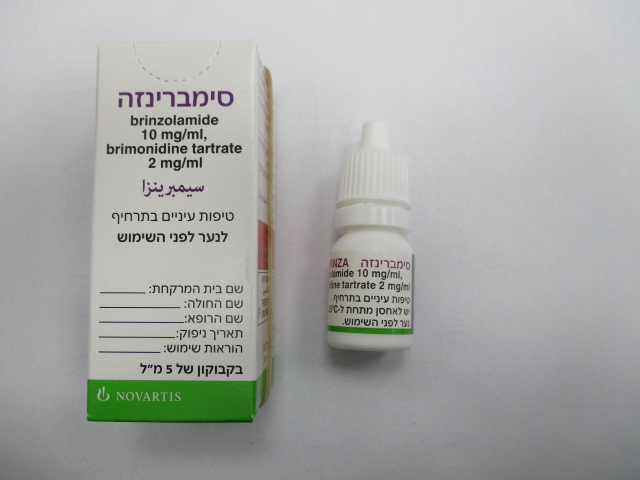Quest for the right Drug

סימברינזה SIMBRINZA (BRIMONIDINE TARTRATE, BRINZOLAMIDE)
תרופה במרשם
תרופה בסל
נרקוטיקה
ציטוטוקסיקה
צורת מתן:
עיני : OCULAR
צורת מינון:
אין פרטים : EYE DROPS, SUSPENSION
עלון לרופא
מינוניםPosology התוויות
Indications תופעות לוואי
Adverse reactions התוויות נגד
Contraindications אינטראקציות
Interactions מינון יתר
Overdose הריון/הנקה
Pregnancy & Lactation אוכלוסיות מיוחדות
Special populations תכונות פרמקולוגיות
Pharmacological properties מידע רוקחי
Pharmaceutical particulars אזהרת שימוש
Special Warning עלון לרופא
Physicians Leaflet
Adverse reactions : תופעות לוואי
4.8 Undesirable effects Summary of the safety profile In clinical trials involving SIMBRINZA dosed twice daily the most common adverse reactions were ocular hyperaemia and ocular allergic type reactions occurring in approximately 6-7% of patients, and dysgeusia (bitter or unusual taste in the mouth following instillation) occurring in approximately 3% of patients. Tabulated summary of adverse reactions The following adverse reactions have been reported during clinical studies with SIMBRINZA twice-daily dosing and during clinical studies and post-marketing surveillance with the individual components brinzolamide and brimonidine. They are classified according to the subsequent convention: very common (≥ 1/10), common (≥ 1/100 to <1/10), uncommon (≥1/1 000 to <1/100), rare (≥1/10 000 to <1/1 000), very rare (<1/10 000) or not known (cannot be estimated from the available data). Within each frequency-grouping, adverse reactions are presented in order of decreasing seriousness. System Organ Adverse reactions Classification Infections and Uncommon: nasopharyngitis2, pharyngitis2, sinusitis2 infestations Not known: rhinitis2 Blood and lymphatic Uncommon: red blood cells decreased2, blood chloride system disorders increased2 Immune system Uncommon: hypersensitivity3 disorders Psychiatric disorders Uncommon: apathy2, depression2,3, depressed mood2, insomnia1, libido decreased2, nightmares2, nervousness2 Nervous system Common: somnolence1, dizziness3, dysgeusia1 disorders Uncommon: headache1, motor dysfunction2, amnesia2, memory impairment2, paraesthesia2 Very rare: syncope3 Not known: tremor2, hypoaesthesia2, ageusia2 Eye disorders Common: eye allergy1, keratitis1, eye pain1, ocular discomfort1, blurred vision1, abnormal vision3, ocular hyperaemia1, conjunctival blanching3 Uncommon: corneal erosion1, corneal oedema2, blepharitis1, corneal deposits (keratic precipitates)1, conjunctival disorder (papillae)1, photophobia1, photopsia2, eye swelling2, eyelid oedema1, conjunctival oedema1, dry eye1, eye discharge1, visual acuity reduced2, lacrimation increased1, pterygium2, erythema of eyelid1, meibomianitis2, diplopia2, glare2, hypoaesthesia eye2, scleral pigmentation2, subconjunctival cyst2,abnormal sensation in eye1, asthenopia1 Very rare: uveitis3, miosis3 System Organ Adverse reactions Classification Not known: visual disturbances2, madarosis2 Ear and labyrinth Uncommon: vertigo1, tinnitus2 disorders Cardiac disorders Uncommon: cardio-respiratory distress2, angina pectoris2, arrhythmia3, palpitations2,3, heart rate irregular2, bradycardia2,3, tachycardia3 Vascular disorders Uncommon: hypotension1 Very rare: hypertension3 Respiratory, thoracic Uncommon: dyspnoea2, bronchial hyperactivity2, and mediastinal pharyngolaryngeal pain2, dry throat1, cough2, epistaxis2, disorders upper respiratory tract congestion2, nasal congestion1, rhinorrhoea2, throat irritation2, nasal dryness1, postnasal drip1, sneezing2 Not known: asthma2 Gastrointestinal Common: dry mouth1 disorders Uncommon: dyspepsia1, oesophagitis2, abdominal discomfort1, diarrhoea2, vomiting2, nausea2, frequent bowel movements2, flatulence2, hypoaesthesia oral2, paraesthesia oral1 Hepatobiliary disorders Not known: liver function test abnormal2 Skin and subcutaneous Uncommon: dermatitis contact1, urticaria2, rash2, rash tissue disorders maculopapular2, pruritus generalised2, alopecia2, skin tightness2 Not known: Stevens-Johnson syndrome (SJS)/toxic epidermal necrolysis (TEN) (see section 4.4), face oedema3, dermatitis2,3, erythema2,3 Musculoskeletal and Uncommon: back pain2, muscle spasms2, myalgia2 connective tissue disorders Not known: arthralgia2, pain in extremity2 Renal and urinary Uncommon: renal pain2 disorders Not known: pollakiuria2 Reproductive system Uncommon: erectile dysfunction2 and breast disorders System Organ Adverse reactions Classification General disorders and Uncommon: pain2, chest discomfort2, feeling abnormal2, administration site feeling jittery2, irritability2, medication residue1 conditions Not known: chest pain2, peripheral oedema2,3 1 adverse reaction observed with SIMBRINZA 2 additional adverse reaction observed with brinzolamide monotherapy 3 additional adverse reaction observed with brimonidine monotherapy Description of selected adverse reactions Dysgeusia was the most common systemic adverse reaction associated with the use of SIMBRINZA (3.4%). It is likely to be caused by passage of the eye drops in the nasopharynx via the nasolacrimal canal and is mainly attributable to the brinzolamide component of SIMBRINZA. Nasolacrimal occlusion or gently closing the eyelid after instillation may help reduce the occurrence of this effect (see section 4.2). SIMBRINZA contains brinzolamide, which is a sulphonamide inhibitor of carbonic anhydrase with systemic absorption. Gastrointestinal, nervous system, haematological, renal and metabolic effects are generally associated with systemic carbonic anhydrase inhibitors. The same type of adverse reactions attributable to oral carbonic anhydrase inhibitors may occur with topical administration. Adverse reactions commonly associated with the brimonidine component of SIMBRINZA include the development of ocular allergic type reactions, fatigue and/or drowsiness, and dry mouth. The use of brimonidine has been associated with minimal decreases in blood pressure. Some patients who dosed with SIMBRINZA experienced decreases in blood pressure similar to those observed with the use of brimonidine as monotherapy. Reporting of suspected adverse reactions Reporting suspected adverse reactions after authorisation of the medicinal product is important. It allows continued monitoring of the benefit/risk balance of the medicinal product. Any suspected adverse events should be reported to the Ministry of Health according to the National Regulation by using an online form: /https://sideeffects.health.gov.il

שימוש לפי פנקס קופ''ח כללית 1994
לא צוין
תאריך הכללה מקורי בסל
12/01/2017
הגבלות
תרופה מוגבלת לרישום ע'י רופא מומחה או הגבלה אחרת
מידע נוסף
